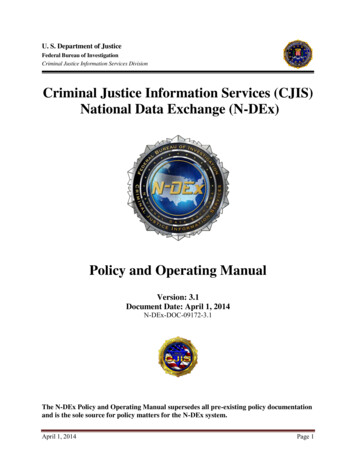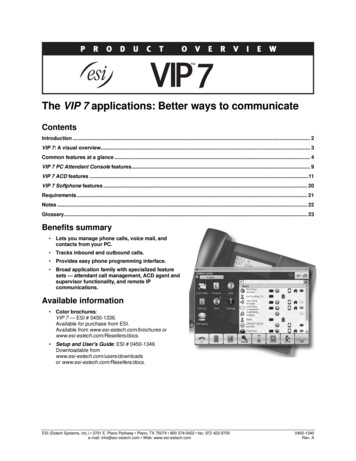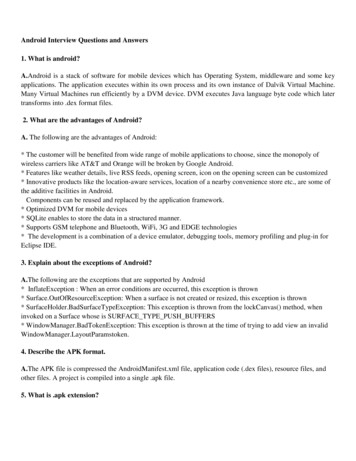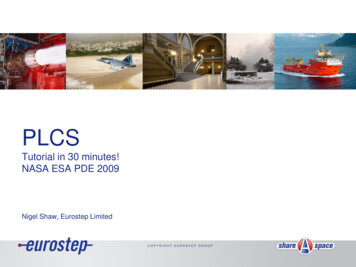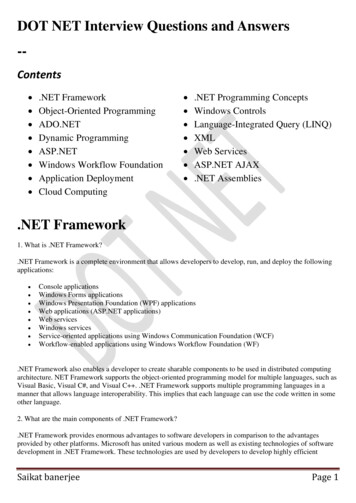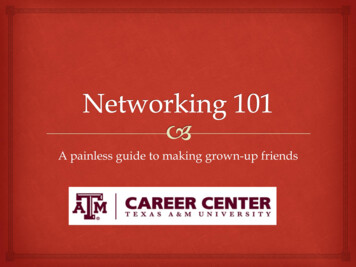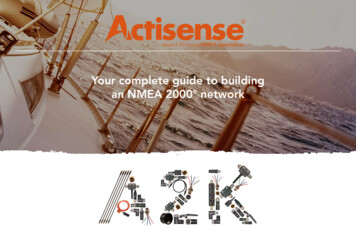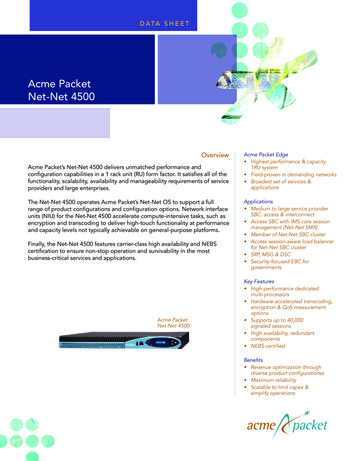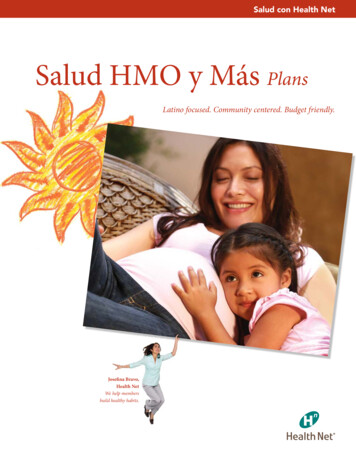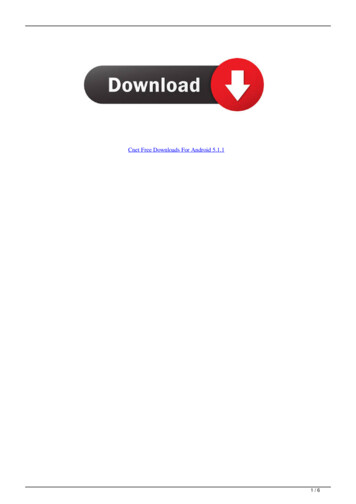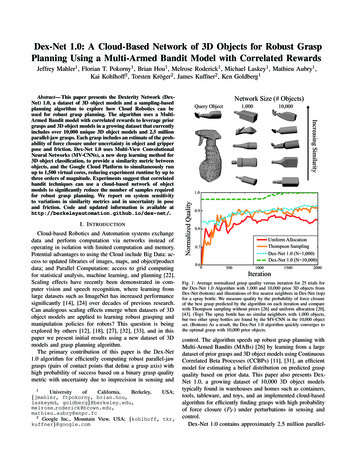
Transcription
Dex-Net 1.0: A Cloud-Based Network of 3D Objects for Robust GraspPlanning Using a Multi-Armed Bandit Model with Correlated RewardsJeffrey Mahler1 , Florian T. Pokorny1 , Brian Hou1 , Melrose Roderick1 , Michael Laskey1 , Mathieu Aubry1 ,Kai Kohlhoff2 , Torsten Kröger2 , James Kuffner2 , Ken Goldberg1Cloud-based Robotics and Automation systems exchangedata and perform computation via networks instead ofoperating in isolation with limited computation and memory.Potential advantages to using the Cloud include Big Data: access to updated libraries of images, maps, and object/productdata; and Parallel Computation: access to grid computingfor statistical analysis, machine learning, and planning [22].Scaling effects have recently been demonstrated in computer vision and speech recognition, where learning fromlarge datasets such as ImageNet has increased performancesignificantly [14], [24] over decades of previous research.Can analogous scaling effects emerge when datasets of 3Dobject models are applied to learning robust grasping andmanipulation policies for robots? This question is beingexplored by others [12], [18], [27], [32], [33], and in thispaper we present initial results using a new dataset of 3Dmodels and grasp planning algorithm.The primary contribution of this paper is the Dex-Net1.0 algorithm for efficiently computing robust parallel-jawgrasps (pairs of contact points that define a grasp axis) withhigh probability of success based on a binary grasp qualitymetric with uncertainty due to imprecision in sensing and1UniversityofCalifornia,Berkeley,USA;{jmahler, ftpokorny, brian.hou,laskeymd, goldberg}@berkeley.edu,melrose roderick@brown.edu,mathieu.aubry@enpc.fc2Google Inc., Mountain View, USA; {kohlhoff, tkr,kuffner}@google.com1,00010,0001.01.0Normalized QualityI. I NTRODUCTIONNetwork Size (# Objects)Query ObjectIncreasing SimilarityAbstract— This paper presents the Dexterity Network (DexNet) 1.0, a dataset of 3D object models and a sampling-basedplanning algorithm to explore how Cloud Robotics can beused for robust grasp planning. The algorithm uses a MultiArmed Bandit model with correlated rewards to leverage priorgrasps and 3D object models in a growing dataset that currentlyincludes over 10,000 unique 3D object models and 2.5 millionparallel-jaw grasps. Each grasp includes an estimate of the probability of force closure under uncertainty in object and gripperpose and friction. Dex-Net 1.0 uses Multi-View ConvolutionalNeural Networks (MV-CNNs), a new deep learning method for3D object classification, to provide a similarity metric betweenobjects, and the Google Cloud Platform to simultaneously runup to 1,500 virtual cores, reducing experiment runtime by up tothree orders of magnitude. Experiments suggest that correlatedbandit techniques can use a cloud-based network of objectmodels to significantly reduce the number of samples requiredfor robust grasp planning. We report on system sensitivityto variations in similarity metrics and in uncertainty in poseand friction. Code and updated information is available 0.90.80.8Uniform AllocationThompson SamplingDex-Net 1.0 (N 1,000)Dex-Net 1.0 (N 10,000)0.70.70.60.600500100015002000IterationFig. 1: Average normalized grasp quality versus iteration for 25 trials forthe Dex-Net 1.0 Algorithm with 1,000 and 10,000 prior 3D objects fromDex-Net (bottom) and illustrations of five nearest neighbors in Dex-Net (top)for a spray bottle. We measure quality by the probability of force closureof the best grasp predicted by the algorithm on each iteration and comparewith Thompson sampling without priors [26] and uniform allocation [20],[43]. (Top) The spray bottle has no similar neighbors with 1,000 objects,but two other spray bottles are found by the MV-CNN in the 10,000 objectset. (Bottom) As a result, the Dex-Net 1.0 algorithm quickly converges tothe optimal grasp with 10,000 prior objects.control. The algorithm speeds up robust grasp planning withMulti-Armed Bandits (MABs) [26] by learning from a largedataset of prior grasps and 3D object models using ContinuousCorrelated Beta Processes (CCBPs) [11], [31], an efficientmodel for estimating a belief distribution on predicted graspquality based on prior data. This paper also presents DexNet 1.0, a growing dataset of 10,000 3D object modelstypically found in warehouses and homes such as containers,tools, tableware, and toys, and an implemented cloud-basedalgorithm for efficiently finding grasps with high probabilityof force closure (PF ) under perturbations in sensing andcontrol.Dex-Net 1.0 contains approximately 2.5 million parallel-
jaw grasps, as each object is labelled with up to 250 graspsand an estimate of PF for each under uncertainty in objectpose, gripper pose, and friction coefficient. To the best of ourknowledge, this is the largest object dataset used for graspingresearch to-date. We incorporate Multi-View ConvolutionalNeural Networks (MV-CNNs) [42], a state-of-the-art methodfor 3D shape classification, to efficiently retrieve similar 3Dobjects for predicting robust grasp quality with CCBPs.We implemented the Dex-Net 1.0 algorithm on GoogleCompute Engine and store Dex-Net 1.0 on Google CloudStorage, with a system that can distribute grasp evaluations for3D objects across up to 1,500 instances at once. Experimentssuggest that using 10,000 prior object models from Dex-Netreduces the number of samples needed to plan parallel-jawgrasps by up to 2 on average over 45 objects when usingPF as a success metric.II. R ELATED W ORKGrasp planning considers the problem of finding grasps fora given object that achieve force closure or optimize a relatedquality metric, such as the epsilon quality [35], correlationwith human labels [2], [18], or success in physical trials.Often it is assumed that the object is known exactly and thatcontacts are placed exactly, and mechanical wrench spaceanalysis is applied. As computing quality metrics can betime consuming, a common grasp planning method is tostore a database of 3D objects labelled with grasps and theirquality and to transfer the stored grasps to similar objects atruntime [5], [41]. To study grasp planning at scale, Goldfederet al. [12], [13] developed the Columbia grasp database,a dataset of 1,814 distinct models and over 200,000 forceclosure grasps generated using the GraspIt! sampling-basedgrasp planner. Pokorny et al. [34] introduced Grasp ModuliSpaces, enabling joint grasp and shape interpolation, andanalyzed a set of 100 million sampled grasp configurations.Robust grasp planning considers optimizing a grasp qualitymetric in the presence of bounded perturbations in propertiessuch as object shape, pose, or mechanical properties suchas friction, which are inevitable due to imprecision inperception and control. One way to treat perturbations isstatistical sampling. Since sampling in high dimensions canbe computationally demanding, recent research has studiedlabelling grasps in a database with metrics that are robust toimprecision in perception and control using probability offorce closure (PF ) [43] or expected Ferrari-Canny quality [23].Experiments by Weisz et al. [43] and Kim et al. [23] suggestthat the robust metrics are better correlated with success ona physical robot than deterministic wrench space metrics.Brook et al. [7] planned robust grasps for a database of 892point clouds and developed a model to predict grasp successon a physical robot based on correlations with grasps in thedatabase. Kehoe et al. [21] created a Cloud-based system totransfer grasps evaluated by PF on 100 objects in a databaseto a physical robot by indexing the objects with the GoogleGoggles object recognition engine.Another line of research has focused on synthesizinggrasps using statistical models [5] learned from a databaseof images [27] or point clouds [9], [15], [46] of objectsannotated with grasps from human demonstrators [15], [27]or physical execution [15]. Kappler et al. [18] created adatabase of over 700 object instances, each labelled with500 Barrett hand grasps and their associated quality fromhuman annotations and the results of simulations with theODE physics engine. The authors trained a deep neuralnetwork to predict grasp quality from heightmaps of thelocal object surface. In comparison, we predict PF givena known 3D object model from similar objects and graspsusing Continuous Correlated Beta Processes (CCBPs) andMulti-Armed Bandits (MABs).Our work is also closely related to research on activelysampling grasps to build a statistical model of grasp quality from fewer examples [10], [25], [36]. Montesano andLopes [31] used Continuous Correlated Beta Processes [11]to actively acquire grasp executions on a physical robotusing image filters to measure similarity. Pinto et al. [33]used importance sampling over grasp success probabilitiespredicted from images by a Convolutional Neural Network(CNN) to actively acquire over 700 hours of labels forsuccessful and unsuccessful 3 DOF crane grasps. Oberlinand Tellex [32] developed a budgeted MAB algorithm forplanning 3 DOF crane grasps using priors from the responsesof hand-designed depth image filters, but did not study theeffects of orders of magnitude of prior data on convergence.In this work we extend the MAB model of [26] from 2Dto 3D and study the scaling effects of using prior data fromDex-Net on robust grasp planning.To use the prior information contained in Dex-Net, we alsodraw on research on 3D model similarity. One line of researchhas focused on shape geometry, such as characteristics ofharmonic functions on the shape [6], or CNNs trained ona voxel representation of shape [30], [45]. Another line ofresearch relies on the description of rendered views of a 3Dmodel [12]. One of the key difficulties of these methodsis comparing views from different objects, which may beoriented inconsistently. Su et al. [42] address this issue byusing CNNs trained for ImageNet classification as descriptorsfor the different views and aggregating them with a secondCNN that learns the invariance to orientation. Using thismethod, the authors improve state-of-the-art classificationaccuracy on ModelNet40 by 10%. We use max-pooling toaggregate views, similar to the average pooling of [1].III. D EFINITIONS AND P ROBLEM S TATEMENTOne goal of Cloud Robotics is to pre-compute a large setof robust grasps for each object so that when the object isencountered, the set can be downloaded such that at least onegrasp is achievable in the presence of clutter and occlusions. Inthis paper we consider the sub-problem of efficiently planninga parallel-jaw grasp that maximizes the expected value of abinary quality metric, such as the probability of force closure(PF ), for a given 3D object model under perturbations inobject pose, gripper pose, and friction coefficient. The DexNet 1.0 algorithm can also produce a set of grasps in rankedorder of robustness. We assume the exact object shape is given
C. Quality Metricx vzxzn1c1 c2ρ1n2ρ2yzFig. 2: Illustration of grasp parameterization and contact model. (Left) Weparameterize parallel-jaw grasps by the centroid of the jaws x R3 andapproach direction, or direction along which the jaws close, v S2 . Theparameters x and v are specified with respect to a coordinate frame at theobject center of mass z and oriented along the principal directions of theobject. (Right) The jaws are closed until contacting the object surface atlocations c1 , c2 R3 , at which the surface has normals n1 , n2 S2 . Thecontacts are used to compute the moment arms ρi ci z.3as a signed distance function (SDF) f : R R [29], whichis zero on the object surface, positive outside the object, andnegative within. We assume the object is specified in unitsof meters with given center of mass z R3 . Furthermore,we assume soft-finger point contacts with a Coulomb frictionmodel [47]. We also assume that the gripper jaws are alwaysopened to their maximal width w R before closing.A. Grasp and Object ParameterizationThe grasp parameters are illustrated in Fig. 2. Let g (x, v) be a parallel-jaw grasp parameterized by the centroidof the jaws in 3D space x R3 and an approach axis v S2 .We denote by O (f, z) an object with SDF f and center ofmass z, and denote by S {y R3 f (y) 0} the surfaceof O. We specify all points with respect to a reference framecentered at the object center of mass z and oriented alongthe principal axes of S.B. ObjectiveThe objective of the Dex-Net 1.0 algorithm is to find agrasp g that maximizes an expected binary grasp qualitymetric S(g) {0, 1} such as force closure [23], [26],[29], [43] subject to uncertainty in the state of the object,environment, or robot. We refer to the expected quality as theprobability of success, PS (g) E[S(g)]. Since sampling inhigh-dimensional spaces can be computationally expensive,we attempt to solve for g in as few samples T as possibleby maximizing over the sum of PS (gt ) for grasps sampledat times t 1, ., T [26], [40]:PTmaximize t 1 PS (gt ).(III.1)In this work we evaluate our algorithm using the probabilityof force closure (PF ), or the ability to resist external forceand torques in arbitrary directions [29], as a quality metric.PF allows us to study the effects of large amounts of data onapproximate solutions of Equation III.1 because it is relativelyinexpensive to evaluate, and PF has also shown promise inphysical experiments [23], [43].Let F {0, 1} denote the occurrence of force closure.For a grasp g on object O under uncertainty in object poseξ, gripper pose ν, and friction coefficient γ the probabilityof force closure PF (g, O) P (F 1 g, O, ξ, ν, γ). Tocompute force closure for a grasp g G on object O Hˆ gripper pose ν̂, and frictiongiven samples of object pose ξ,coefficient γ̂, we first compute a set of possible contactwrenches W using a soft finger contact model [47]. ThenF 1 if 0 is in the convex hull of W [43].D. Sources of UncertaintyFor PF evaluation we assume Gaussian distributions onobject pose, gripper pose, and friction coefficient to modelerrors in registration, robot calibration, or classification ofmaterial properties. Let υ N (0, Συ ) denote a zeromean Gaussian on R6 and µξ SE(3) be the meanobject pose. We define the object pose random variableξ exp (υ ) µξ , where the operator maps from R6 tothe Lie algebra se(3) [3]. Let ν N (0, Σν ) denote zeromean Gaussian gripper pose uncertainty with mean µν G.Let γ N (µγ , Σγ ) denote a Gaussian distribution on theˆ ν̂,friction coefficient with mean µγ R. We denote by ξ,and γ̂ samples of the random variables.E. Contact Modelˆ ν̂,Given a grasp g on object surface f and samples ξ,3and γ̂, let ci R denote the 3D contact location between the i-th jaw and surface as shown in Fig. 2. Letni f (ci )/k f (ci )k2 denote the surface normal andlet ti,1 , ti,2 S2 be its tangent vectors. To computethe forces that each soft contact can apply to the objectfor friction coefficient γ̂, we discretize the friction coneat ci [35] into a set of l facets with vertices Fi 2πjni γ̂ cos 2πjt γ̂sinti,2 j 1, ., l . Thusi,1llthe set of wrenches that g can apply to O is W {wi,j (fi,j , fi,j ρi ) i 1, 2 and fi,j Fi } where ρi (ci z)is the moment arm at ci .IV. D EXTERITY N ETWORKThe Dexterity Network (Dex-Net) 1.0 dataset is a growingset that currently includes over 10,000 unique 3D objectmodels annotated with 2.5 million parallel-jaw grasps.g1 ,.,gT GPast work has solved this objective by evaluating andranking a discrete set of K candidate grasps Γ {g1 , ., gK }using Monte-Carlo integration [20], [43] or Multi-ArmedBandits (MAB) [26]. In this work, we extend the 2D MABmodel of [26] to leverage similarities between prior grasps and3D objects in Dex-Net to reduce the number of samples [16].A. DataDex-Net 1.0 contains 13,252 3D mesh models: 8,987from the SHREC 2014 challenge dataset [28], 2,539 fromModelNet40 [45], 1,371 from 3DNet [44], 129 from the KITobject database [19], 120 from BigBIRD [38], 80 from theYale-CMU-Berkeley dataset [8], and 26 from the Amazon
Picking Challenge scans ( indicates laser-scanner data). Wepreprocess each mesh by removing unreferenced vertices,computing a reference frame with Principal ComponentAnalysis (PCA) on the mesh vertices, setting the mesh centerof mass z to the center of the mesh bounding box, andrescaling the synthetic meshes to fit the smallest dimensionof the bounding box within w 0.1m. To resolve orientationambiguity in the reference frame, we orient the positive z-axistoward the side of the xy plane with more vertices. We alsoconvert each mesh to an SDF using SDFGen [4].0.20.10.0-0.1-0.2Depth (m)c3v3v1c1Depthmap d3c2v2Depthmap d1Depthmap d2Fig. 3: Illustration of three local surface depthmaps extracted on a teapot.Each depthmap is “rendered” along the grasp axis vi at contact ci andoriented by the directions of maximum variation in the depthmap. We usegradients of the depthmaps for similarity between grasps in Dex-Net.B. Grasp SamplingEach 3D object Oi in Dex-Net is labelled with up to250 parallel-jaw grasps and their PF . We generate K graspsfor each object using a modification of the 2D algorithmpresented in Smith et al. [39] to concentrate samples ongrasps that are antipodal [29]. To sample a single grasp, wegenerate a contact point c1 by sampling uniformly from theobject surface S, sampling a direction v S2 uniformlyat random from the friction cone, and finding an antipodalcontact c2 on the line c1 tv where t 0. We add thegrasp gi,k (0.5(c1 c2 ), v) to the candidate set if thecontacts are antipodal [29]. We evaluated PF (gi,k ) usingMonte-Carlo integration [20], [43] by sampling the objectpose, gripper pose, and friction random variables N 500times and recording Zi,k , the number of samples for whichgi,k achieved force closure (F 1).C. Depthmap Gradient FeaturesTo measure grasp similarity in the Dex-Net 1.0 algorithm,we embed each grasp g (x, v) of object O in Dex-Netin a feature space based on a 2D map of the local surfaceorientation at the contacts, inspired by grasp heightmaps [15],[18]. We generate a depthmap di for contact ci by orthogonally projecting the local object surface onto an m mgrid centered at ci and oriented along the line to the objectcenter of mass, ai z ci . Since F only depends on ci andits surface normal, rotations of di about ai correspond tograsps of the equivalent quality. We therefore make each dirotation-invariant by orienting its axes along the eigenvectorsof a weighted covariance matrix of the 3D surface points thatgenerate di as described in [37]. Fig. 3 illustrates local surfacepatches extracted by this procedure. We finally take the xand y-image gradients of di to form depthmap gradients di ( x di , y di ), motivated by the dependence of Fon surface normals [35], and we store each in Dex-Net 1.0.V. D EEP L EARNING FOR O BJECT S IMILARITYWe use Multi-View Convolutional Neural Networks (MVCNNs) [42] to efficiently index prior 3D object and grasp datafrom Dex-Net by embedding each object in a vector spacewhere distance represents object similarity, as shown in Fig. 4.We first render every object on a white background in a totalof C 50 virtual camera views oriented toward the objectcenter and spaced on a grid of angle increments δθ 2π5 andδϕ 2πonaviewingspherewithradiir R,2R,where5R is the maximum dimension of the object bounding box.Max PoolingPCAψ(O)Deep CNNfc7responsefc7responseDeep CNNC2Deep CNNC3Rendered ViewRendered ViewC1Object OFig. 4: Illustration of our Multi-View Convolutional Neural Network (MVCNN) deep learning method for embedding 3D object models in a Euclideanvector space to compute global shape similarity. We pass a set of 50 virtuallyrendered camera viewpoints discretized around a sphere through a deepConvolutional Neural Network (CNN) with the AlexNet [24] architecture.Finally, we take the maximum fc7 response across each of the 50 views foreach dimension and run PCA to reduce dimensionality.Then we train a CNN with the architecture of AlexNet [24]to predict the 3D object class label for the rendered imageson a training set of models. We initialize the weights of thenetwork with the weights learned on ImageNet by Krizhevskyet al. [24] and optimize using Stochastic Gradient Descent(SGD). Next, we pass each of the C views of each objectthrough the optimized CNN and max-pool the output ofthe fc7 layer, the highest layer of the network before theclass label prediction. Finally, we use Principal ComponentAnalysis (PCA) to reduce the max-pooled output from 4,096dimensions to a 100 dimensional feature vector ψ(O).Given the MV-CNN object representation, we measurethe dissimilarity between two objects Oi and Oj by theEuclidean distance kψ(Oi ) ψ(Oj )k2 . For efficient lookupsof similar objects, Dex-Net contains a KD-Tree nearestneighbor query structure with the feature vectors of all priorobjects. In our implementation, we trained the MV-CNN usingthe Caffe library [17] on rendered images from a trainingset of approximately 6,000 3D models sampled from theSHREC 2014 [28] portion of Dex-Net, which has 171 uniquecategories, for 500,000 iterations of SGD. To validate theimplementation, we tested on the SHREC 2014 challengedataset and achieved a 1-NN accuracy of 86.7%, comparedto 86.8% achieved by the winner of SHREC 2014 [28].
VI. C ORRELATED M ULTI -A RMED BANDIT A LGORITHMThe Dex-Net 1.0 algorithm (see pseudocode below) optimizes the probability of success PS (Equation III.1) for abinary quality metric such as force closure over a discreteset of candidate grasps Γ on an object O using a BayesianMulti-Armed Bandit (MAB) model [26], [40] with correlatedrewards [16] and priors computed from Dex-Net 1.0. We firstgenerate the set of K candidate grasps using the antipodalgrasp sampling described in Section IV-B and treat the graspsas “arms” in the MAB model. Next, we predict PS for eachgrasp using the M most similar objects from the Dex-Net1.0 dataset and estimate a Bayesian posterior distributionon our prediction. Then, for iterations t 1, ., T we useThompson sampling [26], [32] to select a grasp gt,k Γ toevaluate, sample the quality S(gt,k ), and update a posteriorbelief distribution on PS for each grasp. Finally, we rank Γby the q-lower confidence bound on PS for each grasp andstore the ranking in the database.To illustrate convergence of the algorithm, we use forceclosure [47] as our binary quality metric. We plan to studyother quality metrics such as success on physical trials [25],[31] and alternate MAB methods based on upper confidencebounds [25], [32] or Gittins indices [26] in future work.A. Model of Correlated RewardsLet Sj S(gj ) {0, 1} be a random binary qualitymetric evaluated on grasp gj Γ. For example, Sj mightmodel force closure under uncertainty in object pose, gripperpose, or friction. Each Sj is a Bernoulli random variable withprobability of success θj PS (gj ).We use Continuous Correlated Beta Processes(CCBPs) [11], [31] to model a joint posterior beliefdistribution over the θj for all grasps in Dex-Net, whichenables us to predict θj from prior grasp and object datain Dex-Net 1.0 using a closed-form posterior update. Thejoint distribution models pairwise correlations of θ betweengrasp-object pairs P (g, O) (points in a Grasp ModuliSpace [34]) measured using a normalized kernel functionk(Pi , Pj ) that approaches 1 as the arguments becomeincreasingly similar and approaches 0 as the argumentsbecome dissimilar.Dex-Net 1.0 measures similarity using a set of featuremaps ϕm Rdm for m 1, ., 3, where dm is thedimension of the feature space for each. The first featuremap ϕ1 (P) (x, v, kρ1 k2 , kρ2 k2 ) captures similarity in thegrasp parameters, where x R3 is the grasp center, v S2 isthe approach axis, and ρi R3 is the i-th moment arm. Thesecond feature map ϕ2 (P) ( d1 , d2 ) uses the depthmapgradients described in Section IV-C. Our third feature mapϕ3 (P) ψ(O) is the object similarity map described inSection V to capture global shape similarity.Given the feature maps, we use the squared exponentialkernel!31 X2k(Yp , Yq ) exp kϕm (Pp ) ϕm (Pq )kCm .2 m 1where Cm Rdm dm is the bandwidth for ϕm and kykCm 1y T Cmy. The bandwidths are set by maximizing the loglikelihood [11] of the true θ on a set of training data.B. Predicting Grasp Quality Using Prior DataBefore evaluating any grasps in Γ, the Dex-Net 1.0algorithm predicts θj for each candidate grasp gj based on itskernel similarity to all grasps and objects from the Dex-Net1.0 dataset D. In particular, we estimate a Bayesian posteriordensity p(θj ) by treating D as prior observations and usingthe closed form posterior update for CCBPs [11]:αp(θj αj,0 , βj,0 ) θj j,0αj,0 α0 βj,0 β0 1 D KXXi 1 k 1 D KXXi 1 k 1(1 θj )βj,0 1(VI.1)k(Pj , Pi,k )Zi,k(VI.2)k(Pj , Pi,k )(N Zi,k ) (VI.3)where α0 and β0 are prior parameters for the Beta distribution [26], N is the number of times each grasp gi,k D wassampled to estimate θi , and Zi,k is the number of observedsuccesses for gi,k . Intuitively, the prior dataset contributesfractional observations of successes and failures for the graspcandidates Γ proportional to the kernel similarity. We estimatethe above sums using the M nearest neighbors to O in theobject similarity KD-Tree described in Section V.C. Grasp Selection PolicyOn iteration t we select the next grasp to sample gj Γusing Thompson Sampling. In Thompson Sampling we drawa sample θˆ p(θ α ,t , β ,t ) for each grasp g Γ, thenchoose the grasp gj with the highest θˆj [26]. After observingSj , we update the belief for all grasps g Γ by updating arunning count of the fractional successes and failures [11]:α ,t α ,t 1 k(P , Pj )Sjβ ,t β ,t 1 k(P , Pj )(1 Sj ).(VI.4)(VI.5)VII. E XPERIMENTSWe evaluate the performance of the Dex-Net 1.0 algorithmon robust grasp planning for varying sizes of prior data usedfrom Dex-Net using force closure as our binary quality metric,and we explore the sensitivity of the convergence rate to objectshape, the similarity kernel bandwidths, and uncertainty. Wecreated two training sets of 1,000, and 10,000 objects byuniformly sampling objects from Dex-Net. We uniformlysampled a set of 300 validation objects for selecting algorithmhyperparameters and selected a set of 45 test objects fromthe remaining objects. We ran the algorithm for T 2, 000iterations with M 10 nearest neighbors, α0 β0 1 [26],and a lower confidence bound containing q 75% of thebelief distribution. We used isotropic Gaussian uncertaintywith object and gripper translation variance σt 0.005,object and gripper rotation variance σr 0.1, and frictionvariance σγ 0.1. For each experiment we compare theDex-Net algorithm to Thompson sampling without priors
234567891011121314Input: Object O, Number of Candidate Grasps K, Number ofNearest Neighbors M , Dex-Net 1.0 Dataset D, Feature mapsϕ, Maximum Iterations T , Prior beta shape α0 , β0 , LowerBound Confidence q, Quality Metric SResult: Estimate of the grasp with highest PF , ĝ // Generate candidate grasps and priorsΓ AntipodalGraspSample(O, K) ;A0 , B0 ;for gk Γ do// Equations VI.2 and VI.3αk,0 , βk,0 ComputePriors(O, gk , D, M, ϕ, α0 , β0 );A0 A0 {αk,0 }, B0 B0 {βk,0 };end// Run MAB to Evaluate Graspsfor t 1, ., T doj ThompsonSample(At 1 , Bt 1 );Sj SampleQuality(gj , O, S);// Equations VI.4 and VI.5At , Bt UpdateBeta(j, Sj , Γ);gt MaxLowerConfidence(q, At , Bt );endreturn gT ;Dex-Net 1.0 Algorithm: Robust Grasp Planning UsingMulti-Armed Bandits with Correlated Rewards(TS) [26], a state-of-the-art method for robust grasp planning,and uniform allocation (UA), a widely-used method for robustgrasp planning that selects the next grasp to evaluate uniformlyat random [20], [23], [43].The inverse kernel bandwidths were selected by maximizing the log-likelihood of the true PF under the CCBPmodel [11] on the validation set using a grid search overhyperparameters. The inverse bandwidths of the similaritykernel were Cg diag(0, 0, 3 10 5 , 3 10 5 ) for the graspparameter features, an isotropic Gaussian mask Cd with meanµd 500.0 and σd 0.33 for the differential depthmaps,and Cs 106 I for the shape similarity features.To scale experiments, we developed a Cloud-based systemon top of Google Cloud Platform. We used Google ComputeEngine (GCE) to construct the Dex-Net 1.0 dataset and todistribute subsets of objects to virtual machines for MABexperiments, and we used Google Cloud Storage to store DexNet. The system launched up to 1,500 GCE virtual instancesat once for experiments, reducing the runtime by an estimatedthree orders of magnitude to approximately 315 seconds perobject for both loading the dataset and running the Dex-Net1.0 algorithm. Each virtual instance ran Ubuntu 12.04 on asingle core with 3.75 GB of RAM.A. Scaling of Average Convergence RateTo examine the effects of orders of magnitude of prior dataon convergence to a grasp with high PF , we ran the DexNet 1.0 algorithm on the test objects with priors computedfrom 1,000 and 10,000 objects from Dex-Net. Fig. 5 showsthe normalized PF (the ratio of the PF for the best grasppredicted by the algorithm to the highest PF of the candidategrasps) versus iteration averaged over 25 trials for each of the45 test objects to facilitate comparison across objects. Theaverage runtime per iteration was 16 ms for UA, 17 ms forTS, and 22 ms for Dex-Net 1.0. The algorithm with 10,0001.0Normalized Quality10.90.8Uniform AllocationThompson SamplingDex-Net 1.0 (N 1,000)Dex-Net 1.0 (N 10,000)0.70.60100050015002000IterationFig. 5: Average normalized grasp quality versus iteration over 45 test objectsand 25 trials per object for the Dex-Net 1.0 algorithm with 1,000 and 10,000prior 3D objects from Dex-Net. We measure quality by the PF for thebest grasp predicted by the alg
0.9 0.8 0.7 0.6 0 500 1000 1500 2000 Iteration Normalized Quality Query Object 1,000 10,000 Network Size (# Objects) Increasing Similarity 1.0 0.9 0.8 0.7 0.6 0 Fig. 1: Average normalized grasp quality versus iteration for 25 trials for Dex-Net (bottom) and illustrations of five nearest neighbors in Dex-Net (top) for a spray bottle.
